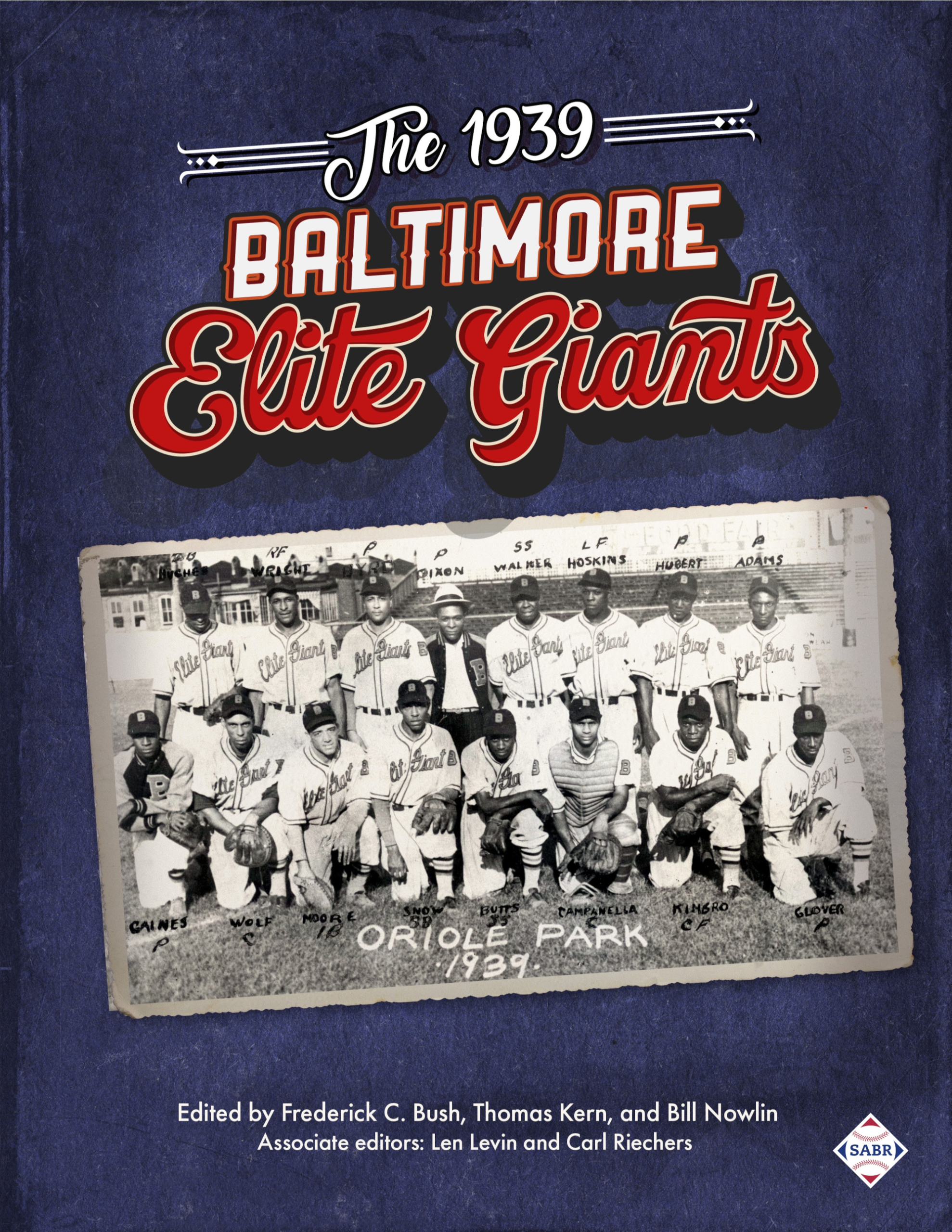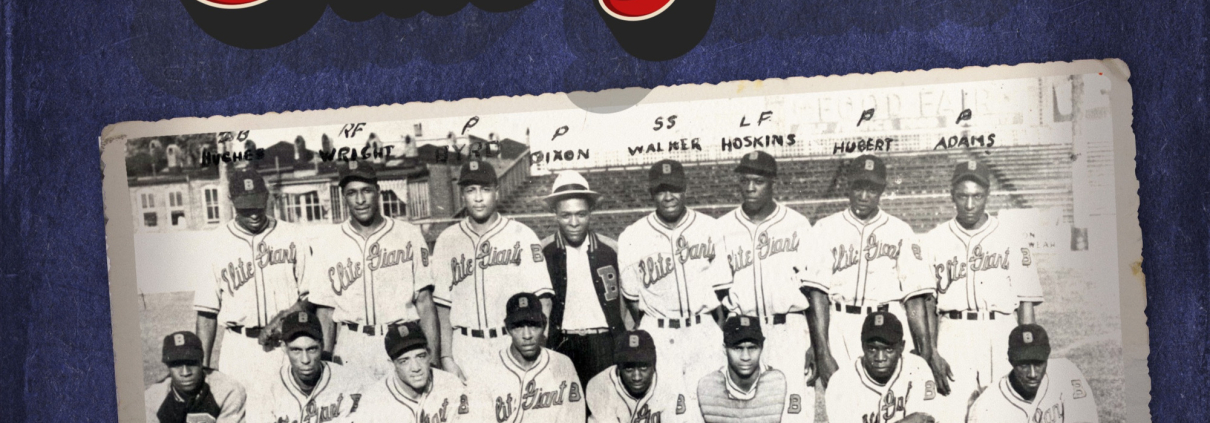The Baltimore Elite Giants and Baseball in 1939
This article was originally published in The 1939 Baltimore Elite Giants (SABR, 2024), edited by Frederick C. Bush, Thomas Kern, and Bill Nowlin.
 In 1939 the minor-league Baltimore Orioles, winners of seven consecutive International League pennants from 1919 to 1925, endured a losing season under first-year manager Rogers Hornsby, the 43-year-old future Hall of Famer. Still, without a successful Orioles season to celebrate, the achievements by the other hometown team, the Elite Giants, did not seem to offer solace and the team’s 1939 Negro National League championship drew little attention in the city’s leading newspaper.1 When the Baltimore Sun selected Maryland’s top sports standouts at year end, both were from Frederick County: New York Yankees rookie Charlie Keller, and Challedon, the Preakness Stakes winner and American Horse of the Year.2
In 1939 the minor-league Baltimore Orioles, winners of seven consecutive International League pennants from 1919 to 1925, endured a losing season under first-year manager Rogers Hornsby, the 43-year-old future Hall of Famer. Still, without a successful Orioles season to celebrate, the achievements by the other hometown team, the Elite Giants, did not seem to offer solace and the team’s 1939 Negro National League championship drew little attention in the city’s leading newspaper.1 When the Baltimore Sun selected Maryland’s top sports standouts at year end, both were from Frederick County: New York Yankees rookie Charlie Keller, and Challedon, the Preakness Stakes winner and American Horse of the Year.2
Although the Yankees won their fourth straight World Series, it would be a mistake to think that little had changed for the champions in pinstripes, or baseball itself, in 1939. Lou Gehrig’s streak of 2,130 consecutive games played ended on May 2. Seven weeks later Gehrig was diagnosed with amyotrophic lateral sclerosis (ALS). On the Fourth of July at Yankee Stadium, the player nicknamed the Iron Horse delivered his iconic “Today, I consider myself the luckiest man on the face of the earth” speech.
On June 12, 1939, the National Baseball Hall of Fame opened in Cooperstown, New York. Ten of the original 13 inductees were introduced to the crowd (Ty Cobb arrived late; Willie Keeler and Christy Mathewson had already died) and Commissioner Kenesaw Mountain Landis remarked, “I should like to dedicate this museum to all America, to lovers of good sportsmanship, healthy bodies and keen minds. For those are the principles of baseball.”3
A New York Times headline the next day read, “Baseball Pageant Thrills 10,000 at Game’s 100th Birthday Party.”4 The US Post Office issued a 3-cent “Centennial of Baseball” stamp.5 The truth expressed in Harrington “Kit” Crissey’s 1976 Baseball Research Journal piece – “Serious baseball research has refuted the earlier contention that Abner Doubleday laid out the first baseball diamond at Cooperstown, N.Y. in 1839 while a cadet at the U.S. Military Academy” – had not yet taken root.6
The inaugural Little League game was played on June 6, 1939, in Williamsport, Pennsylvania. (Lundy Lumber defeated Lycoming Dairy, 23-8.)7 On May 17 baseball was broadcast on TV for the first time, with Princeton defeating Columbia University, 2-1, in an “Ivy League” (the title did not become official until 1954) clash. “The players were best described by observers as appearing ‘like white fliers’ running across the screen,” the Times reported. “It was impossible for the single camera to include both the pitcher’s box and home plate at the same time. When the ball flashed across the grass it was a comet-like white pinpoint. The umpires in the dark uniforms stood out more vividly than did the players in white suits.”8
Television sets had been available to American consumers only since May 1, the day after RCA introduced them at the opening of the World’s Fair in New York City. By the end of the year, only a few hundred US homes had TVs.9
The first major-league games were televised on August 26, 1939, a Brooklyn Dodgers-Cincinnati Reds doubleheader. Empire State Building-based station W2XBS (later WNBC) sent two cameras to capture the action at Ebbets Field, and viewers up to 50 miles away could tune in. Contrasting the telecast to the springtime Princeton-Columbia contest, the Times observed, “It was apparent that considerable progress had been made in the technical requirements and apparatus for this sort of outdoor pick up, where the action is fast. At times it was possible to grasp a fleeting glimpse of the ball as it sped from the pitcher’s hand toward home plate.”10
The NCAA basketball tournament also debuted in 1939. Eight teams competed in the first edition of what eventually came to be called March Madness, with contests in Philadelphia, San Francisco, and Evanston, Illinois. The University of Oregon prevailed by defeating Ohio State, 46-33. Future major-league second baseman Ford “Moon” Mullen was a reserve for the victorious Webfoots.
In college football, the Agricultural and Mechanical College of Texas (now Texas A&M) went undefeated, and 20-year-old Jackie Robinson more than lived up to the hype that accompanied his arrival at the University of California, Los Angeles.11 But the Heisman Trophy went to University of Iowa quarterback Nile Kinnick, who shared Associated Press Athlete of the Year recognition with Alice Marble, the winner of tennis’s singles, doubles, and mixed doubles competitions at both Wimbledon and the US National Championships. (Bobby Riggs, 21, won the men’s singles events at each tournament).
In the National Football League, the Green Bay Packers shut out the New York Giants, 27-0, to secure their fifth championship in 11 years under coach Curly Lambeau. Arguably no athlete was more popular than the Brown Bomber, boxing’s Joe Louis. The Detroit resident defended his heavyweight championship four times, including an 11th-round knockout of Bob Pastor at Briggs Stadium on September 20 that The Ring magazine proclaimed the “Fight of the Year.”
When Time magazine named its Best Song of the [Twentieth] Century in 1999, the choice was Billie Holiday’s “Strange Fruit,” which was recorded on April 20, 1939. In Manhattan’s Sheridan Square that spring, Holiday performed the song nightly at Café Society. “The music is very beautiful and Miss Holiday sings this piece with extraordinary power,” remarked NAACP executive secretary Walter White.12 After Holiday’s recording was released, Variety described it as “Anti-Lynch Propaganda in Swingtime, on a Disc.”13
Originally a 1937 poem by New York City English teacher Abel Meeropol (under his pseudonym Lewis Allan), “Strange Fruit” was inspired by a photograph of two African American teens hanging from a tree after they were lynched in Indiana. “I wrote Strange Fruit because I hate lynching, and I hate injustice, and I hate the people who perpetuate it,” Meeropol explained.14
The number of lynchings in the United States had declined steadily, and sharply, over the previous half-century.15 Yet, as the Baltimore Afro-American newspaper noted on January 6, 1940, “Tuskegee reports three lynchings in 1939, and the NAACP records five. … The main thing we want to point out is that three lynchings are three too many. Even one unpunished lynching is a horror from which civilized people should shrink.”16
In Arlington, Tennessee – the same state where the Negro National League’s Elite Giants had gathered for spring training – an African American sharecropper lost his life because he asked for a receipt on April 28, 1939.17 When a record number of Blacks voted in Miami’s mayoral primary in May, they were met by 50 carloads of Ku Klux Klan members that burned 25 crosses.18
In Baltimore, Mayor Howard W. Jackson was reelected to his third consecutive (and fourth overall) term without incident. However, when the African American associate pastor of Orchard Street Methodist Church attempted to move his family into a home on Baker Street in April, the Sun reported, “A crowd of boys brushed past the police guard stationed there and dragged out several pieces of furniture to the street and smashed them. A crowd of almost 1,000 people participated in the melee and fists were swung freely.”19 Later that spring, the Sun described a new technique that Baltimore’s police commissioner approved for the city’s predominantly Black Western district: “A flying squad of five policemen surrounds a tavern catering to Negro trade, orders all the patrons to line up and then ‘frisks’ them for concealed weapons.”20
In Washington, DC, African American singer Marian Anderson attracted a crowd estimated at 75,000 on Easter Sunday.21 Although the 52-year-old contralto had entertained audiences across Europe and the United States for years, her concert took place on the steps of the Lincoln Memorial because the Daughters of the American Revolution had denied her permission to sing at the DAR’s historic Constitution Hall, citing an unwritten “Whites only” policy. One of the thousands of DAR members who resigned in protest was Eleanor Roosevelt, the wife of President Franklin D. Roosevelt. That summer, the first lady appeared at the NAACP convention to present Anderson the Spingarn Medal.22
In retrospect, many historians cite 1939 as the end of the decade-long Great Depression, though it was hardly a smooth transition.23 On the first day of 1940, the Associated Press reported, “The Stock Market underwent the shock of tremendous and confusing events in 1939 – events, perhaps, eventually of more far-reaching import than the economic collapse of 1929. The price wheel turned the full circle, from boom to bust and back to boom again.”24
On December 31, 1939, the Sun published an Institute of Public Opinion piece that noted, “First and foremost in the minds of Americans at the year’s end is the outbreak of war last September between England and France on one side and Germany on the other – an event which has been foreseen and dreaded by the average American for the last several years.”25 Although the United States remained officially neutral in the conflict that later escalated into World War II, Germany’s September 1 invasion of Poland was overwhelmingly opposed by most US citizens, who supported the French and British 84 percent to 2 percent, according to a Gallup poll that appeared on the same page of the newspaper. (The Soviet Union’s incursion into Finland at the end of November – ordered by Josef Stalin, Time’s Man of the Year for 1939 – was even less popular, with Americans backing the Finns, 88 percent to 1 percent.)26
Yet, the United States was one of three countries (along with Cuba and Canada) that had refused to allow entry to more than 900 passengers – most of them Jews fleeing persecution in Führer Adolf Hitler’s Nazi Germany – aboard the M.S. St. Louis that spring.27 Instead, they were forced to return to Europe, where more than a quarter of them were likely murdered in the Holocaust.28 Their story became the subject of the 1976 feature film Voyage of the Damned (based on a 1974 book with the same title).
As for the movies released during the Elite Giants’ Negro National League championship year, Michael Glitz opined in a 2008 Huffington Post article, “Film buffs have declared 1939 as the greatest year for movies so many times that it’s seen as historical fact, rather than just a widely accepted opinion.”29 (Hollywood’s Golden Year, 1939, and 1939: Hollywood’s Greatest Year are each titles of books.) Although Mr. Smith Goes to Washington and one of the most successful films of all time, Gone with the Wind, were released after the baseball season, another future cinema classic had its Baltimore premiere about three miles south of Oriole Park in August 1939. “The strangest thing about ‘the Wizard of Oz,’ now at the Century, is that it resembles a color cartoon by Walt Disney,” reported Sun reviewer Donald Kirkley. “It seems at times to have been drawn, rather than enacted on solid stages by living people. One of the greatest technical achievements in screen history, the film is something for grownups, as well as children, to marvel at.”30
The film version of John Steinbeck’s 1937 book Of Mice and Men was also released in 1939 while the new novel that would earn him the Pulitzer Prize, The Grapes of Wrath, topped the New York Times Best Seller List throughout the Elite Giants’ campaign.31
Those who preferred comic books were introduced to Batman in the spring of 1939.32 Shortly after, another Action Comics sensation from the previous year gained his own series with the publication of the inaugural Superman issue.33
Although the Sun and The Sporting News ignored the 1939 Baltimore Elite Giants’ heroics, that fall, Ric Roberts of the Atlanta Daily World proclaimed the Elites “the greatest race baseball team in the business.”34 Their triumph was chronicled by Black newspapers like the Baltimore Afro-American, the New Journal and Guide of Norfolk, Virginia, the New York Amsterdam News, the Chicago Defender, and the Kansas City Call. The Pittsburgh Courier’s Bandy Dixon – conceding that coverage of the Elite Giants’ September 24 championship clincher had been “pushed to the background by the hysteria encircling” Louis’s knockout of Pastor four days earlier – penned a 300-word column on October 7 headlined, “Belated Plaudits for the Title Coup of the Elite Giants.”35 Now, for their success during a year dominated by transformative events, enduring icons, and memorable feats, it is fitting that the members of the 1939 Baltimore Elite Giants receive further overdue recognition.
Born in Baltimore, MALCOLM ALLEN grew up about five miles north of the former site of Oriole Park, where the 1939 Elite Giants played their home games. Now based in Brooklyn, New York, he manages an event production warehouse and enjoys spending time with his wife, Sara, and their two daughters.
Notes
1 Although the dearth of Elite Giants’ coverage was not mentioned specifically, in 2022 the Baltimore Sun Editorial Board published a lengthy apology for news coverage and editorial opinions that “sharpened, preserved and furthered the structural racism that still subjugates Black Marylanders” throughout the first 185 years of the newspaper’s history. Baltimore Sun Editorial Board, “We are Deeply and Profoundly Sorry: For Decades, the Baltimore Sun Promoted Policies that Oppressed Black Marylanders; We are Working to Make Amends,” Baltimore Sun, February 18, 2022, https://www.baltimoresun.com/2022/02/18/we-are-deeply-and-profoundly-sorry-for-decades-the-baltimore-sun-promoted-policies-that-oppressed-black-marylanders-we-are-working-to-make-amends/ (accessed January 28, 2024).
2 “Keller and Challedon Bring Fame to State for Sports Feats in 1939,” Baltimore Sun, December 31, 1939: S3.
3 Arthur J. Daley, “Baseball Pageant Thrills 10,000 at Game’s 100th Birthday Party,” New York Times, June 13, 1939: 1.
4 Daley.
5 Gordon T. Trotter, “Centennial of Baseball,” https://postalmuseum.si.edu/exhibition/about-us-stamps-bureau-period-1894-1939-commemorative-issues-1938-1939/baseball (accessed January 20, 2024).
6 Harrington “Kit” Crissey, “Abner Doubleday Would Have Been Proud,” 1976 Baseball Research Journal), https://sabr.org/journal/article/abner-doubleday-would-have-been-proud/ (accessed January 20, 2024).
7 “History of Little League,” https://www.littleleague.org/who-we-are/history/ (accessed January 20, 2024).
8 “First Television of Baseball Seen,” New York Times, May 18, 1939: 29.
9 “The History of Television (Or, How Did This Get So Big?),” https://www.cs.cornell.edu/~pjs54/Teaching/AutomaticLifestyle-S02/Projects/Vlku/history.html (accessed January 20, 2024).
10 “Games Are Televised,” New York Times, August 27, 1939: S4.
11 Andy Wittry, “Jackie Robinson’s Football Career at UCLA Hinted at Greatness to Come,” NCAA.com, April 14, 2023, https://www.ncaa.com/news/football/article/2022-04-14/jackie-robinsons-football-career-ucla-hinted-greatness-come (accessed January 20, 2024).
12 “Night Club Singer Waxes First Song About Lynching,” New Journal and Guide (Norfolk, Virginia), June 17, 1939: 16.
13 “Anti-Lynch Propaganda in Swingtime, on a Disc,” Variety (Los Angeles), May 10, 1939: (Volume 134, Issue 9): 40.
14 Aida Amoako, “Strange Fruit: The Most Shocking Song of All Time?” BBC.com, April 17, 2019, https://www.bbc.com/culture/article/20190415-strange-fruit-the-most-shocking-song-of-all-time (accessed January 14, 2024).
15 From 1882 to 1968, the Tuskegee Institute recorded 4,742 lynchings in the United States, with 72.6 percent of the victims African Americans. The average number of annual lynchings by decade declined from 154 in the 1890s, to 88.8 in the 1900s, 62.2 in the 1910s, 31.5 in the 1920s, and 12.8 in the 1930s. The last year in which a double-digit number of victims was counted was 1935. http://law2.umkc.edu/faculty/projects/ftrials/shipp/lynchingyear.html (accessed January 14, 2024).
16 “Three Too Many Lynchings” Baltimore Afro-American, January 6, 1940: 4.
17 “Jesse Lee Bond,” Lynching Sites Project, Memphis, https://lynchingsitesmem.org/lynching/jesse-lee-bond# (accessed January 20, 2024).
18 Associated Press, “Miami Negroes Ignore Klan Threat and Cast Record Vote,” Baltimore Sun, May 3, 1939: 2.
19 “Fists Fly Freely in Racial Clash,” Baltimore Sun, April 16, 1939: 3.
20 “Police Flying Squad Seeks to Reduce Cutting Affrays,” Baltimore Sun, June 5, 1939: 18.
21 Edward T. Folliard, “Ickes Introduces Contralto at Lincoln Memorial,” Washington Post, April 10, 1939: 1.
22 Since 1914 the NAACP has presented the Spingarn Medal in most years to an African American for outstanding achievements. As of 2023, Jackie Robinson (1956) and Henry Aaron (1976) were the only baseball players to receive it. Obie S. McCollum, “5,000 See Mrs. Roosevelt Present NAACP Medal to Marian Anderson,” Baltimore Afro-American, July 8, 1939: 1.
23 In 2021 the Harvard Business School published Alberto Cavallo, Sophus A. Reinert, and Federica Gabrieli’s “The Global Great Depression, 1929-1939,” https://www.hbs.edu/faculty/Pages/item.aspx?num=61531 (accessed January 21, 2024). Other examples of 1939 being cited as the end of the Great Depression include Charles P. Kindleberger, The World in Depression 1929-1939 (University of California Press, 2013) and “The Great Depression and New Deal, 1929-1939,” PBS Learning Media, https://ny.pbslearningmedia.org/collection/us-history-collection/era/the-great-depression-and-new-deal-19291939/ (accessed January 21, 2024).
24 Associated Press, “Stocks Confined Throughout Year,” Baltimore Sun, January 1, 1940: 10.
25 Institute of Public Opinion, “Foreign Affairs Crowd Domestic Issues Out of National Limelight,” Baltimore Sun, December 31, 1939: 8.
26 George Gallup, “Gallup Poll: – Reds Anger U.S.,” Baltimore Sun, December 31, 1939: 8.
27 “Voyage of the St. Louis,” Holocaust Encyclopedia, https://encyclopedia.ushmm.org/content/en/article/voyage-of-the-st-louis (accessed January 21, 2024).
28 Scott Miller and Sarah Oglivie, Refuge Denied: The St. Louis Passengers and the Holocaust (Madison: University of Wisconsin Press, 2010), 174-175.
29 Michael Glitz, “DVDs: 1939 – The Best Year for Movies … Ever!” Huffington Post, February 15, 2008, https://www.huffpost.com/entry/dvds-1939-the-best-year-f_b_86897 (accessed January 27, 2024).
30 Donald Kirkley, “A Film Version, with Music, of L. Frank Baum’s ‘The Wizard of Oz’ Shown Here,” Baltimore Sun, August 18, 1939: 10.
31 “Adult New York Times Best Seller Lists for 1939,” Hawes Publications, https://www.hawes.com/1939/1939.htm (accessed January 27, 2024).
32 Alex Zalban, “When ‘Is’ Batman’s Birthday, Actually?” MTV.com, March 28, 2014, https://www.mtv.com/news/xxfa1g/batman-75th-anniversary-birthday-date (last accessed January 27, 2024).
33 “Superman (1939 first series) Comic Books,” https://www.mycomicshop.com/search?TID=22601073 (accessed January 27, 2024).
34 Ric Roberts, “Atlanta Is the No. 1 Ungrateful Sports Town of the Nation,” Atlanta Daily World, October 1, 1939: 8.
35 Bandy Dixon, “Belated Plaudits for the Title Coup of the Elite Giants,” Pittsburgh Courier, October 7, 1939: 17.


